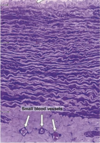B4.020 - Cell Bio and Histology of Vascular System Flashcards
what do pericytes do in the capillaries
these cells allow endothelial cells to multiply and form branches, processes critical for blood vessel growth and repair
what is a key mediator of vessel growth
hypoxia
what type of vessel is this

fenestrated capillary
what allows for continuous capillaries to transport anionic proteins out of blood stream
plasmalemmal vesicles are neutrally charged allowing for transcytosis
caveolae are coated with cytoplasmic surfaces in protein, caveolin
what are capillaries
thin tubes consisting only of endothelial cells and their basement membranes. Small diameter permitting passage of 1 RBC at a time
identify the structures with arrows


describe the 3 tunics of veins
distinction between t media and t adventitia often unclear and a distinct internal elastic lamina is usually absent
T media is thinner than that found in arteries of same diameter
in the case of chronic cell injury what to pericytes do
dedifferentiate into myofibroblast like cells, which are responsible for overproduction of ECM that can lead to fibrosis
how do large elastic arteries sustain continuous blood flow despite intermittend pumping of heart
their walls ditend during systole and recoil during diastole
what is vasculogenesis
creation of a new vascular network
describe tunica externa
connective tissue (large vessels have vasa vasorum, neural tissue)
what is the arrow pointing to

arteriole
identify the 3 types of capillaries

- continous
- fenestrated
- discontinuous
what are the arrows pointing to


describe blood pressure and vascular anatomy

what are caveolae
found in continuous capillaries
help with transport of substances through the cytoplasm in bidirectional pathway (transcytosis)
describe medium sized arteries
muscular arteries
compared with elastic arteries, often see a prominent internal elastic lamina. Also in tunica media there are a fewer elastic sheaths but more prevalent smooth muscle fibers. An external elastic lamina also commonly seen
what type of blood vessel is this

medium artery
how do veins prevent reflux of blood
they have valves
what is an atheroma
when lipids are taken up by macrophages in the tunica intima and fibroblasts of the subendothelial space proliferates
macrophages produce IL-1 and TNF alpha to recruit leukocytees into the atheroma space.
what is angiogenesis
sprouting from an existing network
what are pericytes
contractile cells surrounding some capillaries and post cap venules thought to regulate blood flow.
how does hypoxia lead to vessel growth

what are these

fenestrae with diaphragms
what vessel type regulates the distribution of blood to different capillary beds by vasoconstriction and vasodilation
resistance vessels - arterioles
what are HIF target genes
VEGF
VEGFRs
EPO
GLUT
what are the arrows pointing to

thin discontinuous basement membranes
what are things to look for to identify arteries from veins
arteries are symmetric, veins are not
arteries have more smooth muscle layers


what are the arrows pointing to

top 2 arterioles
bottom - lymph vessel
describe tunica media
concentric layers of smooth muslce, collagen fibers. discontinuous plates of elastic sheaths
what are discontinuous capillaries
have overt gaps between endothelial cells
where is the preferred site of leukocyte egress from blood across vessel walls
veins, post capillary venule
identify the type of capillary

continuous
what are the arrows pointing to

lemphatic vessel with valve
identify the type of capillary

fenestrated
what is depicted here

caveolae
what can loss of pericytes cause
if lost in CNS increase permeability of blood brain barrier and contributes to neurodegenerative disease
what is this

fenestrae without diaphragms
describe tumor angiogenesis
tumors that get larger requires more oxygen and secretes agiogenic factors that stimulate migration, proliferation, neovessel formation by endothelial cells

what type of blood vessel is this

large elastic artery
what is depicted here

diapedesis
where are discontinuous capillaries found
liver, spleen, bone marrow
where are fenestrated capillaries found
sites of fluid transport
Intestine
kidney
what types of plasma proteins are present in plasma
albumin (70%)
gamma globunins (Abs)
fibrinogen
identify the type of capillary

discontinuous
describe the tunica intima
lining of endothelial cells, subendothelial basement membrane and loose connective tissue, dense layer of elastic fibers
where are continuous capillaries found
muslce, brain, thymus, lungs
areas where gas exchange is tightly regulated
what are the 3 types of capillaries
continuous
fenestrated
discontinuous
what are the resistance vessels
arterioles
what are fenestrated capillaries
have pores or fenestrae in endothelium
what do vasculogenesis and angiogenesis both require
VEGF
what is the triangle and arrow pointing to

triangle - pericyte
arrow - venule
what are continuous capillaries
Capillaries with no overt gaps or fenestrae. Pericytes (modified smooth muslce cells) can occur between endothelium and basement membrane
major blood vessels
large elastic artery medium muscular artery small artery arteriole capillary venule medium and large veins


